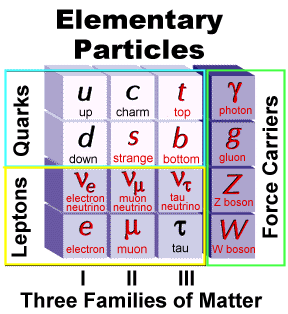Fundamental Particles |
Understanding the basic chemical model of atoms is useful to understanding the more elementary particles. In fact, the chemical model was once thought to consist of fundamental particles. We now know that you can break protons and neutrons up into quarks. The electron remains an absolutely stable particle. So for now, quarks and leptons are the fundamental particles. Naturally, we may find some day that they consist of even smaller, more fundamental particles, but that's irrelevent until provable.
Following are some basic examples of how quarks and leptons work together
The table above is the modern table of elementary particles. The single elemental atoms listed on a periodioc table are all made up of even finer particles, called quarks and leptons. For now, we will only be concerned with the left row of particles .-----> |
 |
Here on Earth, humans pretty much only interact with the first family of matter, so lets ignore the others, just think of them as bigger, more intense versions of the first family of matter for now. So now we have two leptons, and two quarks. Let's construct an atom as it would look on the chemical model with our new elementary particles. |
 (hydrogen) (hydrogen) |
As you can (crudely) see, Hydrogen (being made of only a poroton and an electron) contains two up quarks, one down quark, and an electron lepton. This is a stable configuration, because of the charges involved. Using the charge table could you assume what combination of up and down quarks would make a neutron? |
Particle: Charge
UP: +2/3 DOWN: -1/3 ELECTRON: -1
|
From the table on the left, you can see that the proton has a +1 charge to balance the electron's -1 charge. [+(2/3)+(2/3)-(1/3)=+1] . A neutron, ------------> |
(A single neutron) |
Quarks are bounded together by Gluons to form Hadrons like neutrons and protons.
| Quarks | Gluons | Hadrons |
| So, basically, quarks make up the mass of an object, and the mass does correspond equally to such equations as F=ma, where gravity is involved. This still does not link the theory of general relativity (gravity) to quantum theory. | Gluons are force carriers (see fundamental table above). Gluons are responsible for the strongest known force, so strong it that it can bind two like charges (specifically protons) together, along with neutrons to form a nucleus (the center of an atom). | Hadrons involve a special mathematical system based on "color" charge, a system that seeks neutrality in a much more complicated way than basic electricity's polarity. Hadrons come in two classes: Baryons and Mesons. Two common Baryons are neutrons and protons. A lot of extra particles were found in the 20th century. A large share of them were hadrons formed by specific combinations of quarks. |
Leptons
Leptons (like the electron) are also fundamental particles. They are very light and do not participate in strong interactions caused by the gluon particle. Similar to quarks, only the first family of leptons is stable in our universe. I will discuss some more about electrons when in the electromagnetic force section below.
Another type of Lepton is the neutrino. Each lepton has a neutrino associated with it, and so far, these buggers have been elusive. They are hard to detect since they participate only in the weak and gravitational forces. Neutrinos have no charge associated with them and very little mass
Force Carriers
Amongst all the discoveries in the 20th century, Wave-Particle duality (next chapter) was an important concept to quantum physics.
It eventually even carried through to forces, when scientists found that by describing forces as particles. Here they are listed from strongest to weakest
| Gluons - The Strong Force |
Photons - Electromagnetic Force | Bosons - Weak Force |
Graviton - Gravity |
There are eight color charges associated with gluons, but gluons can also interact with each other to make a variety of color combinations. Quantum Chromo-Dynamics (QCD) is the mathematical study of these interactions. Gluons have an incredibly short range of effect. It can be said that when two quarks interact, the gluon is emitted by one, and absorbed by the other, resulting in color change between the two. Feynman diagrams from this site describe the process more in-depth
|
What we think of as solid strength is thought of in quantum physics as the electromnagetic force. That is, when you punch a steel wall, or sit in a chair, the force that keeps you from entangling molecularly with the object of interaction is the electromagnetic force. Every atom in you and the object is orbited by negatively charge electrons. Because your electrons and the objects electrons are like-charges, you repel each other. The photon is a type of radiation emitted in electromagnetic interactions. More here.
|
The exchange of Bosons in Weak interactions is complicated. One more common weak interaction is called beta decay. Beta Decay is the result of a neutron turning into a proton. When a neutron decays, it becomes a proton, an electron, and a neutrino. Other particles are involved, but these are the particles responsible for the difference in charge and mass between neutrons and protons. more here |
Gravity, the oldest known force, has proven to be the hardest to describe. Newton did an excellent job describing its relationships on a large scale level, but in the quantum world, it is non-existent.
more at: Georgia State University
|
An excellent online resource for Fundamental Particles:
http://www2.slac.stanford.edu/vvc/theory/fundamental.html

